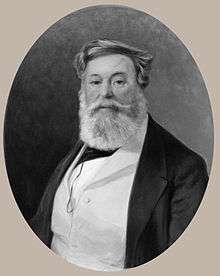Henry Perlee Parker
Henry Perlee Parker (1795–1873) was an English artist, known as a history painter.

Life
The son of Robert Parker, of Plymouth Dock, a teacher of marine and mechanical drawing, was born at Devonport on 15 March 1795. He was trained by his father, but felt cramped in his occupation; in 1815 he married a Miss Amy Morfey of Woodbridge, Suffolk, and set up as a portrait-painter in the Three Towns. He met with little success, migrated to the north, and in 1816 settled at Newcastle upon Tyne.
He made his mark on Tyneside by a picture of Newcastle Eccentrics, representing a group of well-known characters identified with the street life of the town. In 1817 he began exhibiting in London at the British Institution, and shortly afterwards made the acquaintance of Thomas Miles Richardson. They set up in 1822 ‘The Northumberland Institution for the Promotion of the Fine Arts,’ of which Richardson was treasurer and Parker secretary.
He was appointed drawing-master at Wesley College, Sheffield, and left Newcastle, shortly after 1840. On the death of his first wife in 1844 he settled in London, and, having remarried, he survived his second wife, and died on 11 November 1873. He had fourteen children.
Works
He did not confine himself to portraits, but painted historical and marine subjects, and excelled in smugglers, whence the sobriquet ‘Smuggler Parker.’ His pictures sold well. Two large pieces, ‘The Sandhill Wine Pant—coronation of George IV,’ and ‘Fancy Dress Ball in the Mansion House—coronation of William IV,’ were purchased by the corporation of Newcastle. The opening of the new markets at Newcastle in 1835, and the brave deed of Grace Darling in 1838, also formed the subjects of popular pictures by Parker.
In 1835 Parker issued ‘Critiques on Paintings by H. P. Parker … together with a few slight Etchings showing the Compositions,’ &c., Newcastle. In 1840 he presented a representation of the rescue of John Wesley from the fire at Epworth in 1709 to the Wesleyan conference, to be placed in the Centenary Hall, London. Between 1817 and 1863 Parker exhibited eighty-six pictures in London, of which twenty-three were in the Royal Academy.
References
 "Parker, Henry Perlee". Dictionary of National Biography. London: Smith, Elder & Co. 1885–1900.
"Parker, Henry Perlee". Dictionary of National Biography. London: Smith, Elder & Co. 1885–1900.
- Attribution
![]() This article incorporates text from a publication now in the public domain: "Parker, Henry Perlee". Dictionary of National Biography. London: Smith, Elder & Co. 1885–1900.
This article incorporates text from a publication now in the public domain: "Parker, Henry Perlee". Dictionary of National Biography. London: Smith, Elder & Co. 1885–1900.